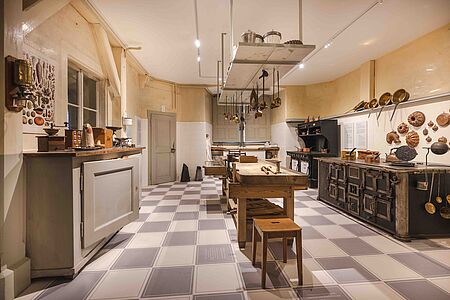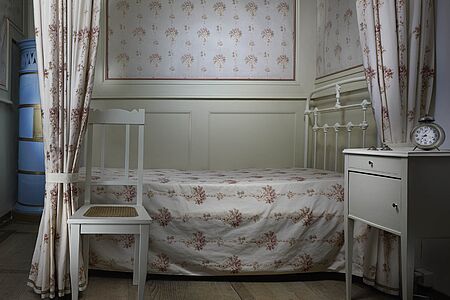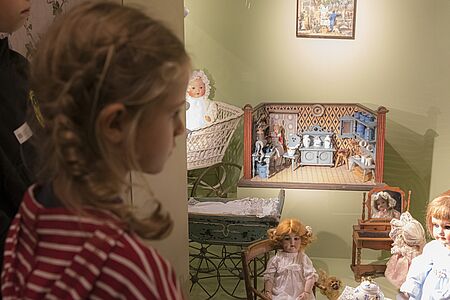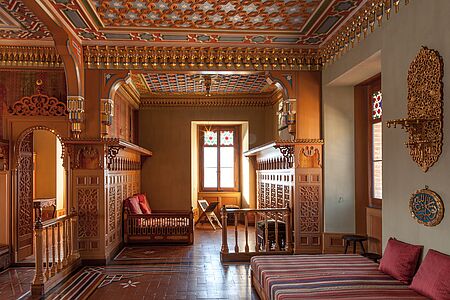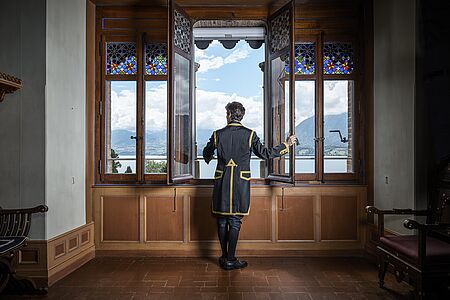Museum & Exhibitions Oberhofen Castle
The castle has had a long and varied history of owners, and has been continuously lived in since the von Eschenbach nobility constructed it by the lake around 1200. From 1652 - 1798, the castle was a bailiff's residence. It later came into private hands and was rebuilt in the historicism style by the Count de Pourtàles family around 1850. The oriental smoking room above the keep dates from this period, and offers breathtaking views. The castle was converted into a museum in the early 1950's.
Special Exhibition
Castle Storys
Oberhofen Castle was a residence until the mid 20th century. Who were the previous owners? And how did it come about that the former fortress became a summer residence for an aristocratic family? Focused on the previous castle occupants, the exhibition traverses more than 800 years of history. The two parts of the permanent exhibition can be found on the first floor.
ARISTOCRATIC LIFE AROUND 1900
In recent years, the former stately rooms on the first floor have been carefully restored. Among them, a bathroom from 1904 commissioned by the castle’s then-owner, Helene Harrach. The “Chambre d’honneur” is also accessible – a guest room reserved for distinguished visitors; likewise, a smaller servant’s room intended for accompanying staff. In an open space outside these rooms, a billiard table stands as a reminder of the pastimes once enjoyed here. The presentation offers a glimpse into the life of the Count’s family, who spent their summers at Lake Thun until the 1920s. Our visitors are welcome to use the billiard table during opening hours! Permanent Exhibition on the 1st Floor (East Wing)
Always at your service
The household of the aristocratic Pourtalès-Harrach family, who lived in the 19th century, would have been inconceivable without domestic staff. Whoever enters the rooms of the servants’ quarters, only recently accessible, is immersed into previously unknown history. The exhibition takes a look at the world of the servants and lets the audience participate in situations that have taken place in the corridors and behind closed doors. It can be found on the second floor.
Always at your service – In the kitchen
Supported by vivid animations and videos, this extension to the permanent exhibition “Always at your service” reveals the servants’ workplace and kitchen life at the turn of the 20th century. During the counts’ tenure, the kitchen catered for many distinguished guests as well as providing daily meals for the family and their servants. In an engaging manner, the exhibition communicates the kitchen world and shows how food was prepared at that time. Ida, a maid whose job included fetching coal for the cooker, also has her say. The staging of the castle kitchen ensures first-hand experiences and that surprising moments arise. Various kitchen utensils are to be discovered, and are sure to evoke nostalgia for the past.
The World of Children
In a room once used as a servant's quarters, a window opens up to the world of the children who lived in the castle from the mid-19th century until the early 1920s. Unfortunately, their toys haven’t been preserved. Our collection of toys, however, illustrates what they likely played with, while also capturing a slice of cultural history.
Oriental Fascination
In the 19th century, Western fascination with the Orient influenced the castle owner, Albert Count de Pourtalès, leading to the construction of a Smoking Room at the top of the keep. The exhibits shown in the former count’s library on the 4th floor should encourage reflection on the perception of the Orient and the concept of Orientalism.
![[Translate to Englisch:] [Translate to Englisch:]](/fileadmin/_processed_/0/4/csm_DSC_1477-min_bf95657599.jpg)
